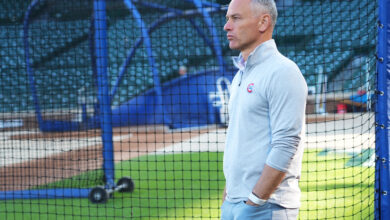
Tyson Miller Learning from Mistakes to Take Next Step in Development
Among the myriad traits the Cubs actively seek out when evaluating players, whether free agents or prospects, is the ability to bounce back from adversity. They value it so highly that Matt Dorey, the club’s senior director of player development, actually said during the Down on the Farm panel at Cubs Convention that he hoped Brennen Davis encountered a few bumps in the road on his rise through the system. Nothing catastrophic, mind you, just enough to test his mettle.
This probably doesn’t come as a surprise to anyone, either because you’ve heard Cubs execs talk about it or because you know how omelettes are made. Or maybe you just understand that the game of baseball isn’t particularly forgiving of those people who can’t handle struggles. The best players aren’t necessarily those who fail less often, but those who can best cope with and learn from their failures.
“We really do focus on how the individual responds to adversity,” Epstein explained to podcast host David Axelrod in 2017. “Because baseball is a game in which…[Axelrod: “You fail all the time”]. Failure is inherent in the game. If you don’t respond well to adversity, you’re probably not going to have any kind of a long career in baseball.”
He’s exactly right, of course, but the tough part is figuring out how to foster that in a player. I mean, all the hitting and pitching labs in the world can’t build a player’s mental skills. Or can they? The switch to MLB baseballs meant a nearly 60% jump in home runs across Triple-A, a phenomenon that left more than a few pitchers perplexed as to why they were suddenly unable to get batters out. Dorey described how the Cubs were able to use Statcast data to explain that some of those homers may have been products of the ball rather than a bad pitch or a good hit.
Dakota Mekkes talked to Cubs Insider about how cans of corn would turn into taters and how some pitchers coming up from Double-A were flummoxed when their pitches would move differently than they had with a minor league ball. That may have been particularly harmful to Tyson Miller, who stumbled out of the gate in the already hitter-friendly Pacific Coast League following a very strong run at Tennessee to open the season. After posting a 2.56 ERA with a minuscule 5.3% walk rate with the Smokies, Miller’s ERA shot to 7.58 and his walks more than doubled to 10.8% at the next level.
“I’m not gonna blame the different ball for why I wasn’t pitching well,” Miller said during a live interview with Cubs Insider and the Myrtle Beach Pelicans. “I was missing a lot of spots and the hitters up there are obviously a lot better than what I’d been facing. They had a plan…they’re not chasing pitches out of the zone, which is what I was good at, trying to make my balls look like strikes and strikes look like balls.
“So just making an adjustment to the better hitters and a little bit with the ball, it’s just a different grip for me especially, like I grip the ball a certain way to try and make my balls move. So it was just a little adjustment for the first five or six starts, but finished fairly well, I think.”
That hiccup is the kind of thing that can turn into an epidemic if it’s not remedied — or maybe just forgotten — quickly. From the sounds of it, that wasn’t and won’t be a problem for Miller, whose California cool keeps him on an even keel on the mound and social media alike.
I appreciate your concern and don’t worry, I’m already working hard this off season to have better numbers than I did last year. Hope to see you out at some games and as always Go Cubbies!🐻🤘🏽 https://t.co/ncud1qrVMW
— Tyson Miller (@Tyson_Miller07) January 13, 2020
“You’re always gonna have your internet trolls, your Twitter trolls, all that stuff,” Miller explained. “You’re not gonna be liked by everyone, especially if you don’t have good numbers, and it was a bad start in Triple-A. But for the most part, you gotta stay positive, you can’t dwell on the on lows and you can’t just obsess over the highs.”
Avoiding those emotional swings can mean the difference between a player everyone keeps hoping can break out and one who channels his talent to make the Show. Miller’s got the stuff and substance to hold down a rotation spot, with a versatile low-90’s fastball and plus secondaries in a slider and changeup that are both excellent when located properly. But if he wants to take the next step, he needs to learn when and where to miss with which of his offerings.
“I know mechanical-wise, we’re trying to tune up some stuff, [but] more just trying to have a plan of how to adjust to hitters mid-at-bat instead of after the at-bat,” Miller said of his plan heading into the season.
Miller’s addition to the Cubs’ 40-man roster back in November wasn’t entirely expected, but it was a very clear sign that the organization has a great deal of faith in him. It’s also a sign that he could be up in Chicago at some point in 2020 to help the rotation and/or bullpen, something Dorey indicated was a possibility. Now all Miller’s got to do is learn from his past mistakes and make fewer of them in the future.
For more on Miller’s journey in the game, as well as an explanation of his extensive collection of tattoos, check out the full video of our interview below.

